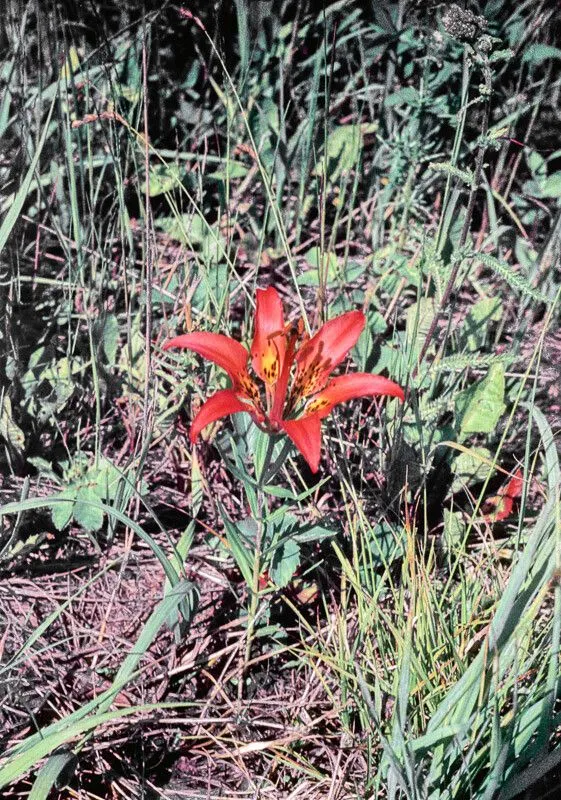
Author: L.
Bibliography: Sp. Pl. ed. 2: 435 (1762)
Year: 1762
Status: accepted
Rank: species
Genus: Lilium
Vegetable: False
Observations: Canada to WC. & E. U.S.A.
The Flame lily, scientifically known as Lilium philadelphicum, is a captivating perennial plant native to North America. It belongs to the Liliaceae family and was first described in detail by the renowned botanist Carl Linnaeus in the second edition of his seminal work “Species Plantarum” published in 1762.
This striking plant is typically found in natural habitats ranging from Canada to the western and eastern regions of the United States. The Flame lily thrives in open woods, meadows, and prairies, often gracing these areas with its vibrant orange-red flowers adorned with speckles of darker hues. Its blooms stand out vividly against the lush green foliage, making it a favorite among nature enthusiasts and horticulturists alike.
The Flame lily features a singular, unbranched stem that can reach impressive heights, showcasing a series of whorled leaves that are lanceolate to elliptic in shape. The flowers, usually appearing in the early summer months, are distinguished by their six petal-like tepals that curve slightly backward, creating a stunning, trumpet-shaped blossom.
Apart from its visual appeal, Lilium philadelphicum holds ecological significance as well. It plays a vital role in supporting local pollinators, particularly butterflies and bees, which are drawn to its nectar-rich flowers. This symbiotic relationship makes the Flame lily an integral component of the ecosystems where it naturally occurs.
Cultivating the Flame lily in gardens can be highly rewarding. It flourishes in well-drained soil with adequate sunlight, although it can also tolerate partial shade. Gardeners should ensure that the soil remains moist but not waterlogged, as this plant prefers a balanced moisture level. When properly cared for, the Flame lily can become a long-lasting, perennial fixture in gardens, offering years of spectacular blooms.
In summary, Lilium philadelphicum, or the Flame lily, is a remarkable plant that combines aesthetic beauty with ecological importance. Its historical recognition and botanical attributes make it a cherished species both in the wild and in cultivated settings, continuing to capture the admiration of those who encounter its fiery blossoms.
Eng: flame lily, glade lily, huckleberry lily, orange-cup lily, red lily, western wood lily, wild lily, wild orange lily, wild orange-red lily, wood lily, red wood lily
Swe: bägarlilja
Fra: lis de philadelphie
En: Flame lily, Orange-cup lily, Red lily, Western wood lily, Wood lily, Huckleberry lily, Wild lily, Wild orange lily, Wild orange-red lily, Glade lily, Red wood lily
Fr: Lis de Philadelphie
Sv: Bägarlilja
Taken Mar 8, 2014 by EOL − Aarongunnar (cc-by-sa)
Taken Aug 4, 2014 by EOL − Sara (cc-by-nc)
Taken Sep 14, 2014 by EOL − Janelle Veenendaal (cc-by-nc)
Taken Nov 13, 2013 by EOL − Daniel Carter (cc-by-nc)
Taken Feb 24, 2022 by Martin Bishop (cc-by-sa)
Taken Jul 16, 2019 by David David Schulz (cc-by-sa)
Taken Jul 9, 2021 by Bonnie Nederlof (cc-by-sa)
Taken Jul 4, 2020 by Jill B (cc-by-sa)
Taken Jul 18, 2019 by David David Schulz (cc-by-sa)
Taken Feb 14, 2022 by Viorica Colomeet (cc-by-sa)
Taken Jun 30, 2017 by Harv Gamble (cc-by-sa)
Taken Jul 26, 2022 by Tina Witham (cc-by-sa)
Taken Jun 23, 2021 by amanda kukle (cc-by-sa)
Taken Jun 25, 2022 by Francesca Valotto (cc-by-sa)
© copyright of the Board of Trustees of the Royal Botanic Gardens, Kew.
© copyright of the Board of Trustees of the Royal Botanic Gardens, Kew.
Growth habit>: Forb/herb
Family: Myrtaceae Author: (F.Muell.) K.D.Hill & L.A.S.Johnson Bibliography: Telopea 6: 402 (1995) Year: 1995 Status:…
Family: Rubiaceae Author: Pierre ex A.Froehner Bibliography: Notizbl. Bot. Gart. Berlin-Dahlem 1: 237 (1897) Year:…
Family: Sapindaceae Author: Koidz. Bibliography: J. Coll. Sci. Imp. Univ. Tokyo 32(1): 38 (1911) Year:…
Family: Asteraceae Author: A.Gray Bibliography: Pacif. Railr. Rep.: 107 (1857) Year: 1857 Status: accepted Rank:…
Family: Fabaceae Author: Medik. Bibliography: Vorles. Churpfälz. Phys.-Ökon. Ges. 2: 398 (1787) Year: 1787 Status:…
Family: Aspleniaceae Author: (Cav.) Alston Bibliography: Bull. Misc. Inform. Kew 1932: 309 (1932) Year: 1932…